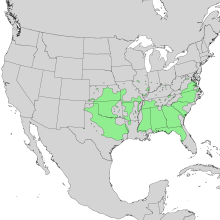Prunus angustifolia
| Prunus angustifolia | |
|---|---|
 | |
| Scientific classification | |
| Kingdom: | Plantae |
| Clade: | Angiosperms |
| Clade: | Eudicots |
| Clade: | Rosids |
| Order: | Rosales |
| Family: | Rosaceae |
| Genus: | Prunus |
| Subgenus: | Prunus subg. Prunus |
| Section: | Prunus sect. Prunocerasus |
| Species: | P. angustifolia |
| Binomial name | |
| Prunus angustifolia | |
 | |
| Natural range of Prunus angustifolia | |
| Synonyms[1] | |
| |
Prunus angustifolia pronounced (PROO-nus an-gus-tih-FOLE-ee-uh), known commonly as Chickasaw plum, Cherokee plum, Florida sand plum, sandhill plum, or sand plum,[2] is a North American species of plum-bearing tree. It was originally cultivated by Native Americans before the arrival of Europeans [3][4][5] While Prunus is the classical name for European plums, angustifolia refers to its narrow leaves.

Description
Chickasaw plum grows 12 to 20 feet tall and 15 to 20 feet wide in an irregular shape. It is "twiggy" in nature, and has a scaly, almost black bark. Its branches are reddish with thorn-like, small side branches. In February, March, April and May, small white flowers blossom, 8–9 mm wide, along with red plums, up to 25 mm long. The flowers have five white petals with reddish or orange anthers. The plums are cherry-like and tend to be quite tart until they fully ripen.[6] They ripen in late summer. It requires low to medium amounts of water to grow, and dry, sandy or loose soil. It grows best in areas with regular sunlight or areas of partial shade. In sunny areas, it will be more dense and colonize thickly. In areas of partial shade, it will be thinner and less dense, and each plant will be more spread out. P. angustifolia is very difficult to distinguish from Prunus umbellata, with which it hybridizes easily.[7]
Location
Prunus angustifolia is widespread across much of the eastern and central United States from Florida west as far as New Mexico and Colorado, north to Nebraska, Illinois, and New Jersey, with a few isolated populations in northern Michigan.[8] The species grows in dry and sandy soils, such as open woodlands, woodland edges, forest openings, savannahs, prairies, plains, meadows, pastures, and roadsides. It is listed by the USDA as an endangered species in the state of New Jersey.
Taxonomy
American plum (Prunus americana Marsh.) hybridizes naturally with P. angustifolia to produce P. × orthosepala Koehne.[9]
Uses
Chickasaw plums tend to bloom early in the spring. Because they bloom early in the spring, before many other plants bloom, and require very little maintenance, they are often used in horticulture for ornamental use. They are found along many highways, especially in the southern part of the United States. The fruit is eaten by various animals. It also provides cover for nesting sites. Ripe fruits are slightly tart, but can be eaten or are sometimes made into jellies, desserts and preserves. Because of its attractive bark, small leaves and thin branches, Chickasaw plum is also sometimes used for bonsai.[10]
References
| Wikimedia Commons has media related to Prunus angustifolia. |
- ↑ "The Plant List: A Working List of All Plant Species". Retrieved January 27, 2014.
- ↑ "Prunus angustifolia". Germplasm Resources Information Network (GRIN). Agricultural Research Service (ARS), United States Department of Agriculture (USDA). Retrieved 12 January 2018.
- ↑ Bartram, W. Travels through North and South Carolina, Georgia, East and West Florida. 1791.
- ↑ Sargent, C. S. Manual of the trees of North America. 2nd Ed. Vol. II. Dover Pub., Inc. New York. 934p. 1965.
- ↑ Little, E. L. Checklist of United States Trees. USDA Forest service. Washington, D.C. 1979.
- ↑ Boning, Charles R. (2006). Florida's Best Fruiting Plants: Native and Exotic Trees, Shrubs, and Vines. Sarasota, Florida: Pineapple Press, Inc. p. 77. ISBN 1561643726.
- ↑ "Plum Delicious and Native, Too!". Florida Native Plant Society. July 15, 2011. Retrieved December 28, 2014.
- ↑ Biota of North America Program 2014 county distribution map
- ↑ Lee, Sangtae; Wen, Jun. (2001). A phylogenetic analysis of Prunus and the Amygdaloideae (Rosaceae) using ITS sequences of nuclear ribosomal DNA. American Journal of Botany. 88(1): 150-160.
- ↑ Edward F. Gilman and Dennis G. Watson. "Prunus angustifolia: Chickasaw Plum1". Retrieved 3 May 2011.